1993 CHEVROLET ASTRO PASSENGER stop start
[x] Cancel search: stop startPage 150 of 345
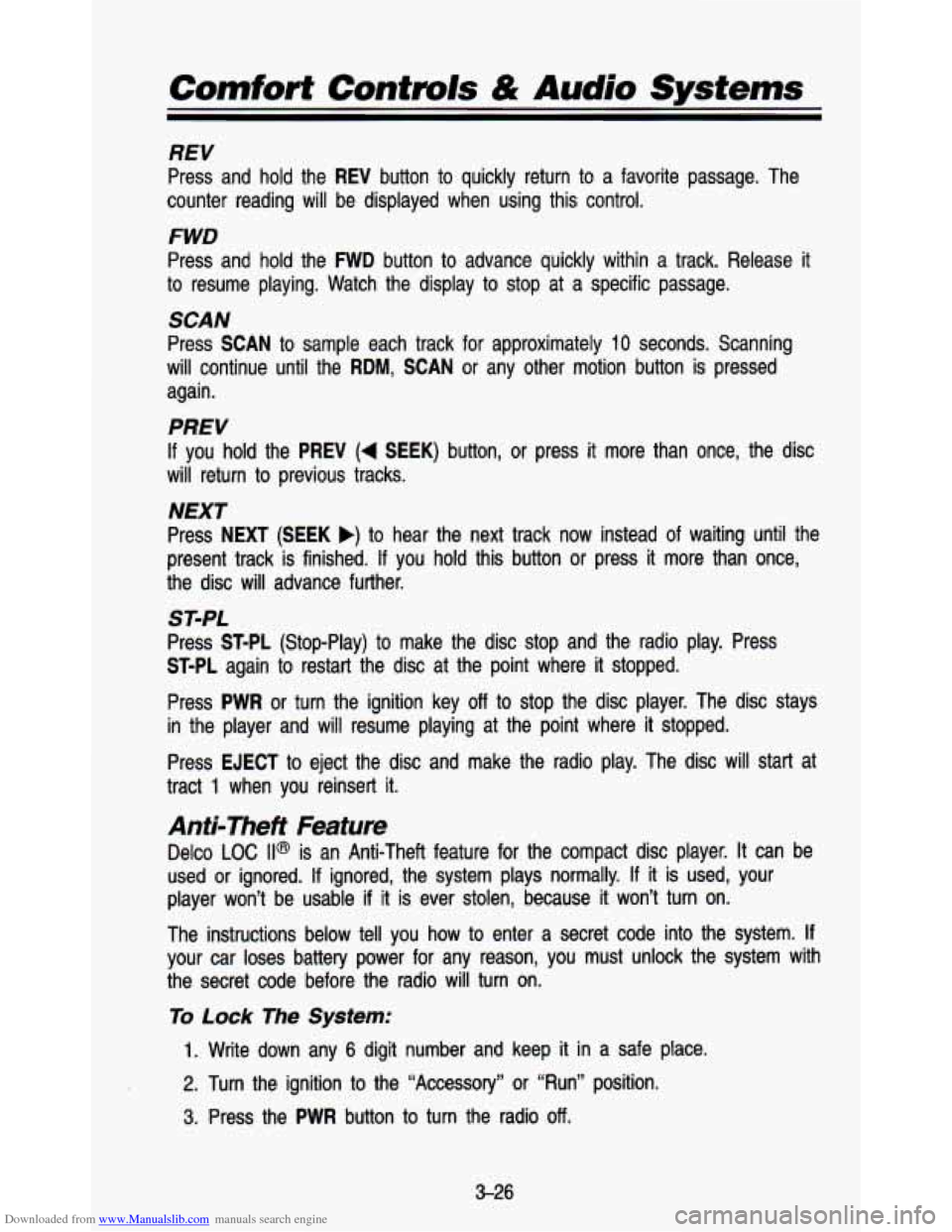
Downloaded from www.Manualslib.com manuals search engine Comfort Contmls & Audio Systems
REV
Press and hold the REV button to quickly return to a favorite passage. The
counter reading will be displayed when using this control.
FWD
Press and hold the FWD button to advance quickly within a track. Release it
to resume playing. Watch the display to stop at a specific pa\
ssage.
SCAN
Press SCAN to sample each track for approximately 10 seconds. Scanning
will continue until the
RDM, SCAN or any other motion button is pressed
again.
PREV
If you hold the PREV (4 SEEK) button, or press it more than once, the disc
will return to previous tracks.
NEXT
Press NEXT (SEEK b) to hear the next track now instead of waiting until the
present track is finished.
If you hold this button or press it more than once,
the disc
will advance further.
ST-Pf
Press ST-PL (Stop-Play) to make the disc stop and the radio play. Press
ST-PL again to restart the disc at the point where it stopped.
Press
PWR or turn the ignition key off to stop the disc player. The disc stays
in the player and will resume playing at the point where it \
stopped.
Press
EJECT to eject the disc and make the radio play. The disc will sta\
rt at
tract
1 when you reinsert it.
Anti-Theft Feature
Delco LOC Il@ is an Anti-Theft feature for the compact disc player. It can be
used or ignored. If ignored, the system plays normally.
If it is used, your
player won’t be usable if it is ever stolen, because it wo\
n’t turn
on.
The instructions below tell you how to enter a secret code in\
to the system. If
your car loses battery power for any reason, you must unlock \
the system with
the secret code before the radio will turn on.
To Lock The System:
1. Write down any 6 digit number and keep it in a safe place.
2. Turn the ignition to the “Accessory” or “Run” position.
3. Press the PWR button to turn the radio off.
3-26
Page 162 of 345
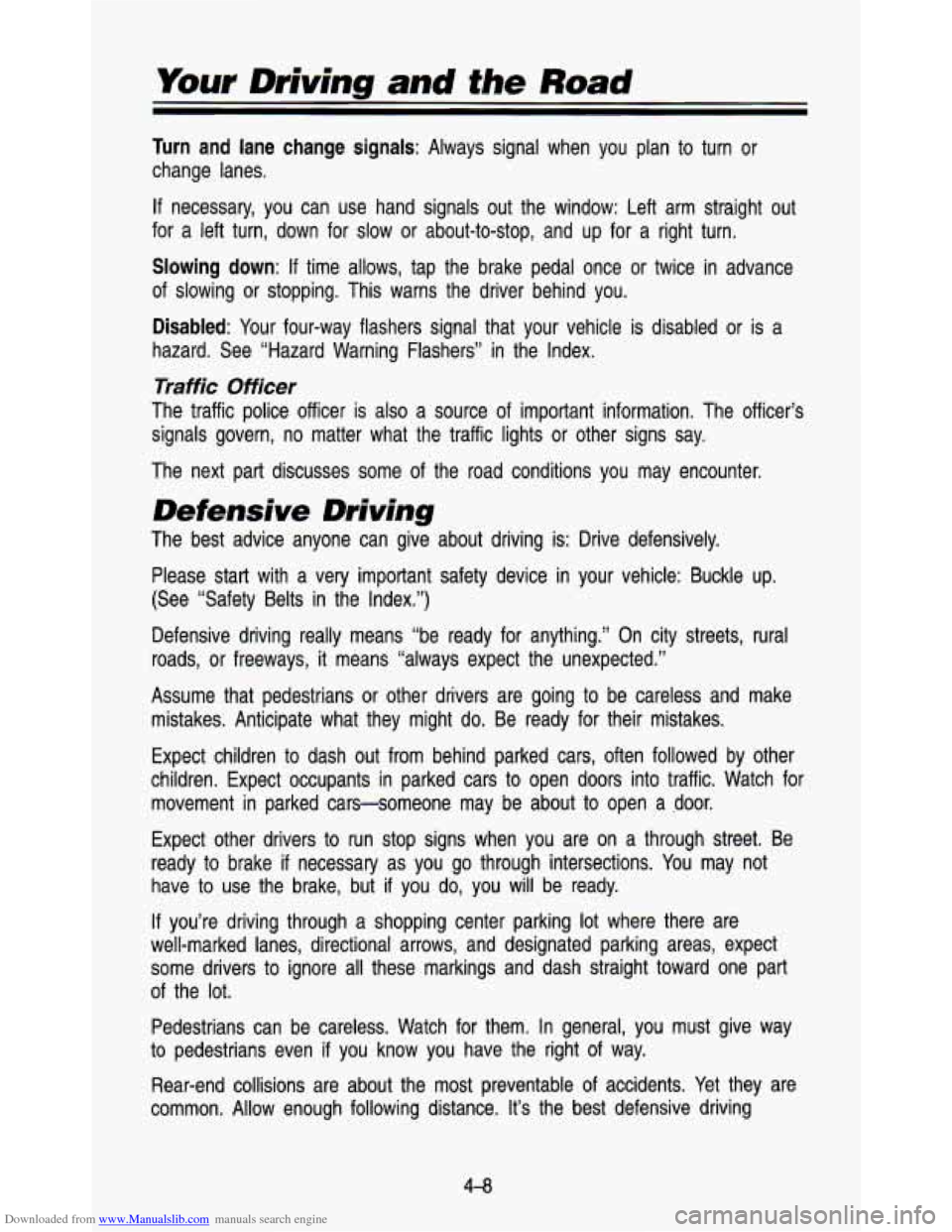
Downloaded from www.Manualslib.com manuals search engine Your Driving and the Road
Turn and lane change signals: Always signal when you plan to turn or
change lanes.
If necessary, you can use hand signals out the window: Left arm \
straight out
for a left turn, down for slow or about-to-stop, and up for \
a right turn.
Slowing down: If time allows, tap the brake pedal once or twice in advance
of slowing or stopping. This warns the driver behind you.
Disabled: Your four-way flashers signal that your vehicle is disabled or is a\
hazard. See “Hazard Warning Flashers” in the Index.
Traffic Officer
The traffic police officer is also a source of important information. The officer’s
signals govern, no matter what the traffic lights or other sig\
ns say.
The next part discusses some of the road conditions you may encounter.
Defensive Driving
The best advice anyone can give about driving is: Drive defens\
ively.
Please start with a very important safety device in your vehic\
le: Buckle up.
(See “Safety Belts in the Index.”)
Defensive driving really means “be ready for anything.’’\
On city streets, rural
roads, or freeways, it means “always expect the unexpected.”
Assume that pedestrians or other drivers are going to be carel\
ess and make mistakes. Anticipate what they might
do. Be ready for their mistakes.
Expect children
to dash out from behind parked cars, often followed by other
children. Expect occupants in parked cars
to open doors into traffic. Watch for
movement in parked cars-someone may be about
to open a door.
Expect other drivers
to run stop signs when you are on a through street. Be
ready to brake if necessary as you go through intersections. You may not
have to use the brake, but
if you do, you will be ready.
If you’re driving through a shopping center parking lot where t\
here are
well-marked lanes, directional arrows, and designated parking are\
as, expect
some drivers to ignore all these markings and dash straight to\
ward one part
of the lot.
Pedestrians can be careless. Watch for them. In general, you m\
ust give way
to pedestrians even
if you know you have the right of way.
Rear-end collisions are about the most preventable of accidents. Yet they are
common. Allow enough following distance.
It’s the best defensive driving
4-0
Page 168 of 345
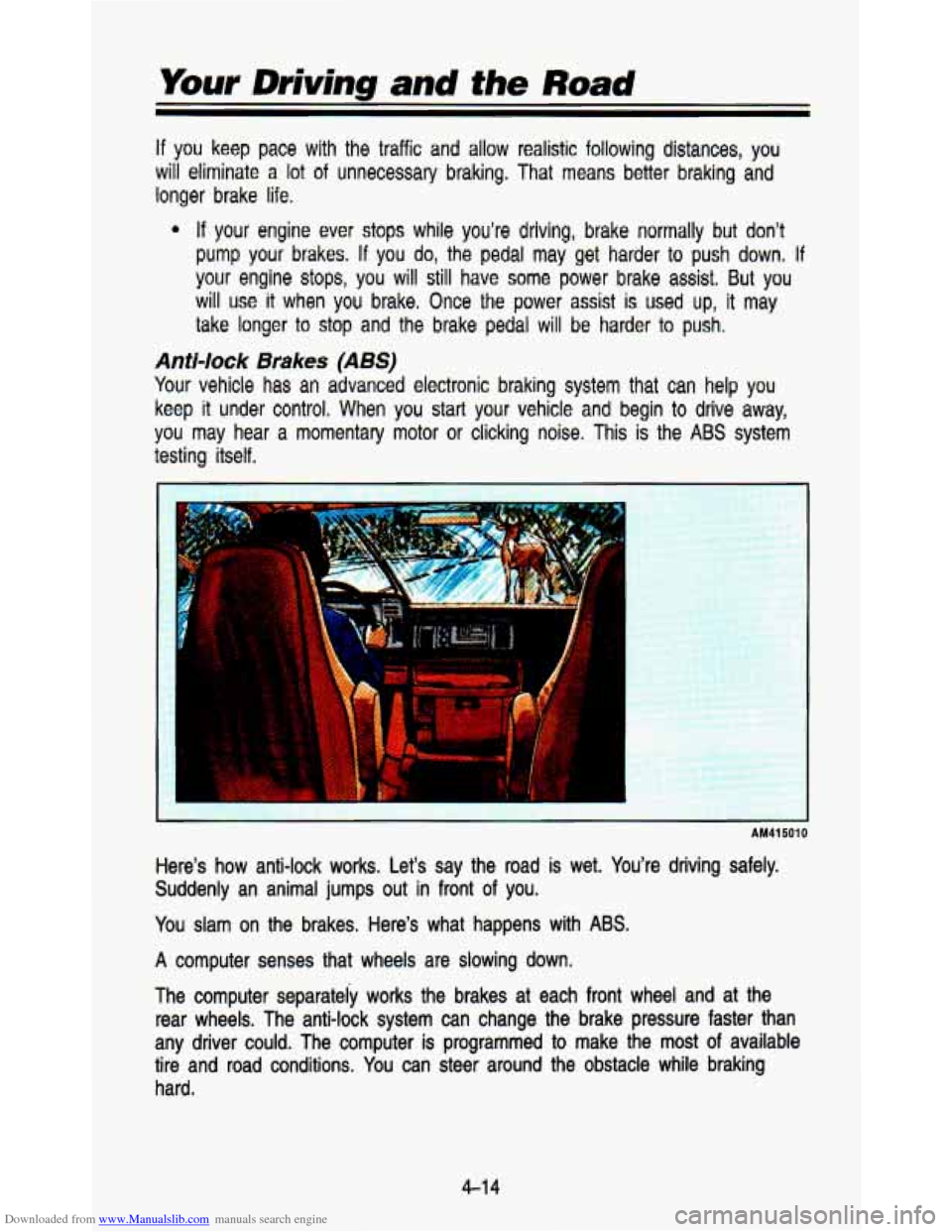
Downloaded from www.Manualslib.com manuals search engine If you keep pace with the traffic and allow realistic following distances, you
will eliminate
a lot of unnecessary braking. That means better braking and
longer brake
life.
4 If your engine ever stops while you’re driving, brake normally but don’t
pump your brakes. If you do, the pedal may get harder to push down. If
your engine stops, you will still have some power brake assist. But you
will
use it when you brake, Once the power assist is used up, it may
take longer
to stop and the brake pedal will be harder to push.
Anti-lOCk Brakes (ABS)
Your vehicle has an advanced electronic braking system that can help you
keep
it under control. When you start your vehicle and begin to drive \
away,
you may hear a momentary motor
or clicking noise. This is the ABS system
testing itself.
AM41 501 0
Here’s how anti-lock works. Let’s say the road is wet. You’re driving safely.
Suddenly an animal jumps out in front of you.
You slam on the brakes. Here’s what happens with
ABS.
A computer senses that wheels are slowing down.
The computer separately works the brakes at each front wheel a\
nd
at the
rear wheels. The anti-lock system can change the brake pressure\
faster than
any driver could. The computer is programmed
to make the most of available
tire and road conditions.
You can steer around the obstacle while braking
hard.
4-1 4
Page 175 of 345
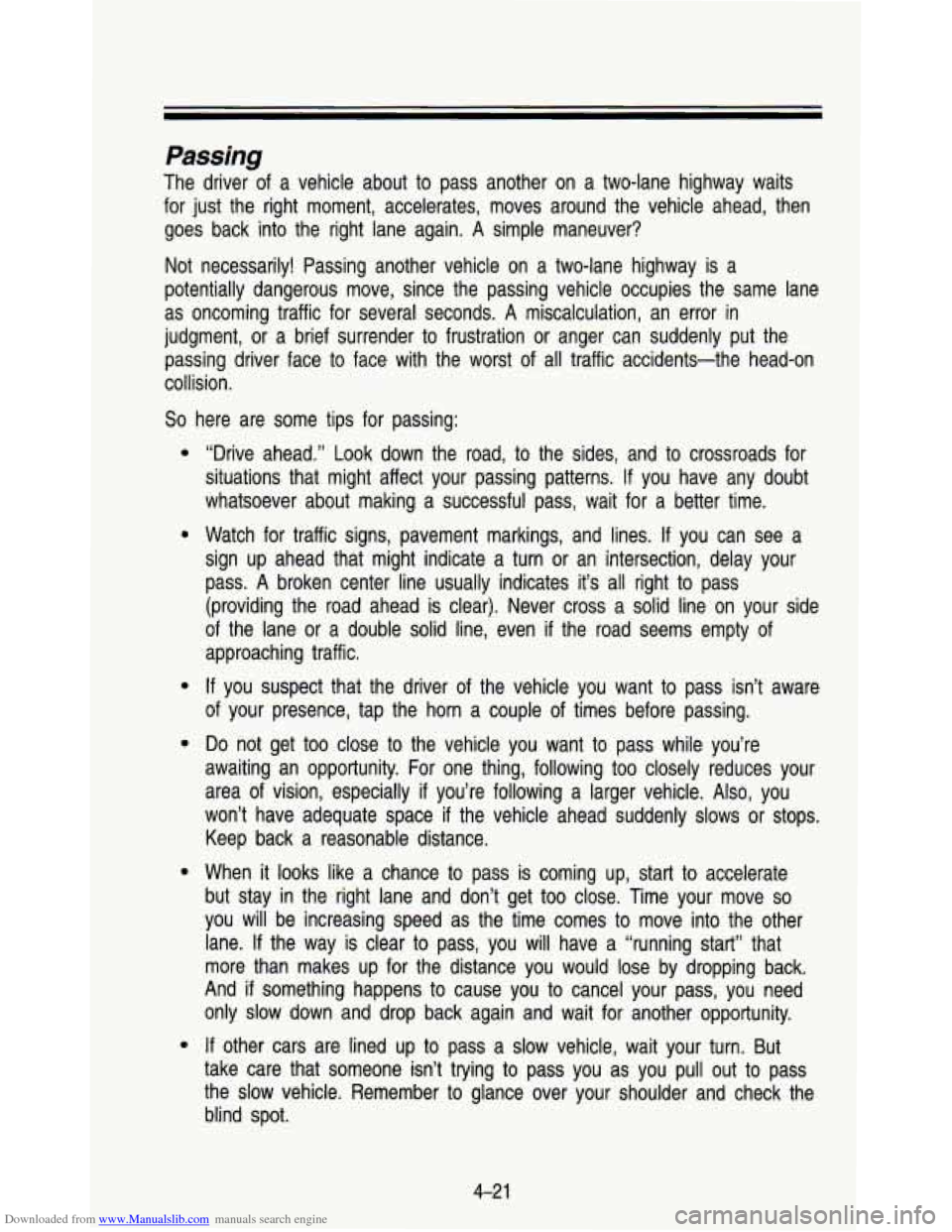
Downloaded from www.Manualslib.com manuals search engine Passing
The driver of a vehicle about to pass another on a two-lane highway waits
for just the right moment, accelerates, moves around the vehicle ahead, then
goes back into the right lane again.
A simple maneuver?
Not necessarily! Passing another vehicle on a two-lane highway is a
potentially dangerous move, since the passing vehicle occupies the same lane
as oncoming traffic for several seconds.
A miscalculation, an error in
judgment, or a brief surrender
to frustration or anger can suddenly put the
passing driver face to face with the worst of all traffic accidents-the head-on
collision.
So here are some tips for passing:
“Drive ahead.” Look down the road, to the sides, and
to crossroads for
situations that might affect your passing patterns. If you have\
any doubt
whatsoever about making a successful pass, wait for a better t\
ime.
Watch for traffic signs, pavement markings, and lines.
If you can see a
sign up ahead that might indicate a turn or an intersection, delay your
pass. A broken center line usually indicates it’s all right
to pass
(providing the road ahead is clear). Never cross a solid line on your side
of the lane or a double solid line, even if the road seems empty of
approaching traffic.
If you suspect that the driver of the vehicle you want to pass isn’t aware
of your presence, tap the horn a couple of times before passing.
Do not get too close to the vehicle you want to pass while you’re
awaiting an opportunity. For one thing, following too closely r\
educes your
area of vision, especially
if you’re following a larger vehicle. Also, you
won’t have adequate space
if the vehicle ahead suddenly slows or stops.
Keep back a reasonable distance.
When
it looks like a chance to pass is coming up, start to accelerate
but stay in the right lane and don’t get too close. Time your move
so
you will be increasing speed as the time comes to move into \
the other
lane.
If the way is clear to pass, you will have a “running start” that
more than makes up for the distance you would lose by dropping back.
And
if something happens to cause you to cancel your pass, you need
only
slow down and drop back again and wait for another opportunity.
If other cars are lined up to pass a slow vehicle, wait your turn. But
take care that someone isn’t trying to pass you as you pull
out to pass
the
slow vehicle. Remember to glance over your shoulder and check the
blind spot.
4-2 1
Page 180 of 345

Downloaded from www.Manualslib.com manuals search engine Your Driving and #he Road
Driving in the Rain
1 I
I
Rain and wet roads can mean driving trouble. On a wet road y\
ou can’t stop,
accelerate or turn as well because your tire-to-road traction isn’t as good as
on
dry roads. And, if your tires don’t have much tread left, you’ll get even
less traction.
It’s always wise to go slower and be cautious
if rain starts to fall while you
are driving. The sutface may get wet suddenly when your reflexes a\
re tuned
for driving on dry pavement.
The heavier the rain, the harder
it is to see. Even if your windshield wiper
blades are in good shape, a heavy rain can make
it harder to see road signs
and traffic signals, pavement markings, the edge of the road, and even
people walking. Road spray can often be worse for vision than \
rain,
especially
if it comes from a dirty road.
So it is wise to keep your wiping equipment in good shape and keep your
windshield washer tank filled. Replace your windshield wiper inserts when \
they
show signs
of streaking or missing areas on the windshield, or when strips of
rubber start
to separate from the inserts.
4-26
Page 183 of 345

Downloaded from www.Manualslib.com manuals search engine that you can see only a few feet (meters) ahead. It may come suddenly to
an otherwise clear road. And it can be a major hazard.
When you drive into a fog patch, your visibility will be ieduced quickly. The
biggest dangers are striking the vehicle ahead
or being struck by the one
behind. Try
to “read” the fog density down the road. If the vehicle ahead
starts
to become less clear or, at night, if the taillights are harder to see, the
fog is probably thickening. Slow down to give traffic behind y\
ou a chance
to
slow down. Everybody then has a better chance to avoid hitting the vehicle
ahead.
A patch of dense fog may extend only for a few feet (meters) or for miles
(kilometers); you can’t really tell while you’re in
it. You can only treat the
situation with extreme care.
One common fog condition-sometimes called mist
or ground fog-can
happen in weather that seems perfect, especially at night
or in the early
morning in valley and low, marshy areas. You can be suddenly enveloped in
thick, wet haze that may even coat your windshield. You can often spot these
fog patches
or mist layers with your headlights. But sometimes they can be
waiting for you as you come over a hill
or dip into a shallow valley. Start
your windshield wipers and washer,
to help clear accumulated road dirt. Slow
down carefully.
Tips on Driving in Fog
If you get caught in fog, turn your headlights on low beam, even\
in daytime.
You’ll see-and be seen-better. Use your fog lights
if your vehicle has them.
Don’t use your high beams. The light will bounce
off the water droplets that
make up fog and reflect back at you.
Use your defogger. In high humidity, even a light buildup of moisture on the
inside
of the glass will cut down on your already limited visibility. Ru\
n your
windshield wipers and washer occasionally. Moisture can build up\
on the outside glass, and what seems to be fog may actually be moist\
ure on the
outside of your windshield.
Treat dense fog as an emergency.
Try to find a place to pull off the road. Of
course you want
to respect another’s property, but you might need to put
something between you and moving vehicles-space, trees, telephone poles,
a private driveway, anything that removes you from other traffi\
c.
If visibility is near zero and you must stop but are unsure whether you are
away from the road, turn your lights on, start your hazard warning flashers,
and sound your horn at intervals
or when you hear approaching traffic.
4-29
Page 184 of 345
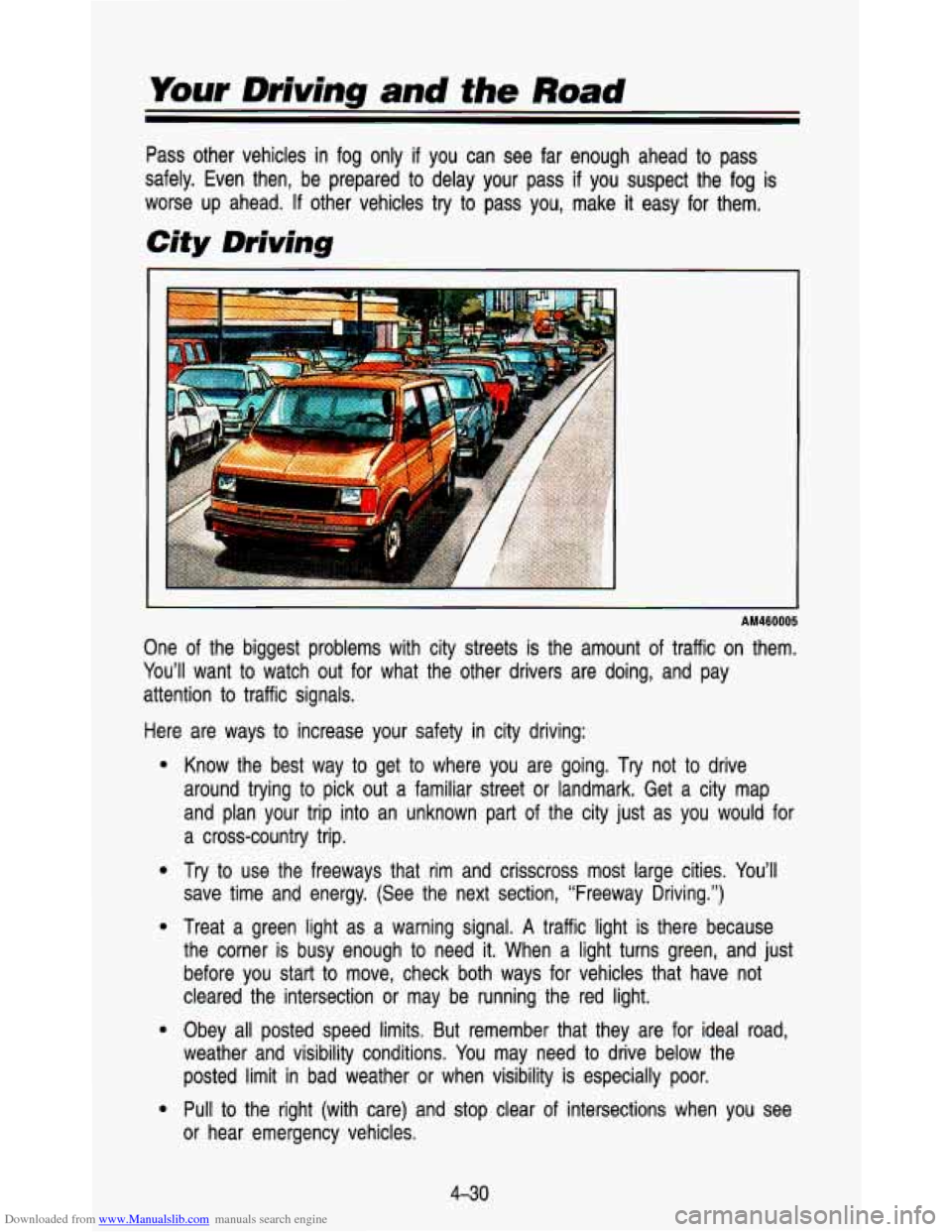
Downloaded from www.Manualslib.com manuals search engine Your Driving and the Road
Pass other vehicles in fog only if you can see far enough ahead to pass
safely. Even then, be prepared to delay your pass
if you suspect the fog is
worse up ahead.
If other vehicles try to pass you, make it easy for them.
City Driving
AM460005
One of the biggest problems with city streets is the amount of traffic on them.
You’ll want to watch out for what the other drivers are doing, and pay
attention to traffic signals.
Here are ways to increase your safety in city driving:
e
e
e
e
Know the best way to get to where you are going. Try not to drive
around trying to pick out a familiar street or landmark. Get \
a city map
and plan your trip into an unknown part of the city just as you would for
a cross-county trip.
Try to use the freeways that rim and crisscross most large cities. You’ll
save time and energy. (See the next section, “Freeway Drivi\
ng.”)
Treat a green light as a warning signal.
A traffic light is there because
the corner is busy enough to need
it. When a light turns green, and just
before you start to move, check both ways for vehicles that have not
cleared the intersection or may be running the red light.
Obey all posted speed limits. But remember that they are for ideal road,
weather and visibility conditions. You may need to drive below the
posted limit in bad weather
or when visibility is especially poor.
Pull to the right (with care) and stop clear of intersections when y\
ou see
or hear emergency vehicles.
430
Page 186 of 345
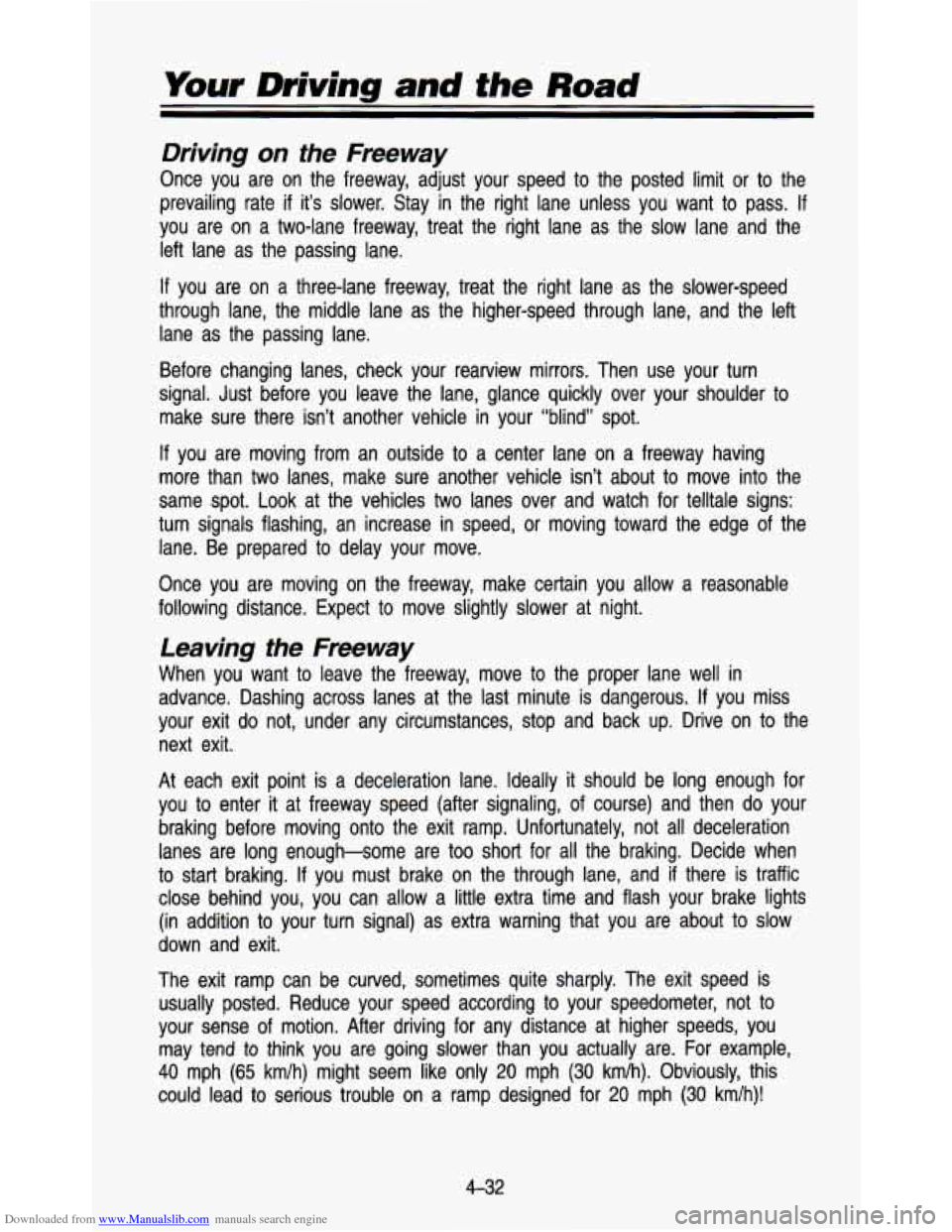
Downloaded from www.Manualslib.com manuals search engine Your Driving and the Road
Driving on the Freeway
Once you are on the freeway, adjust your speed to the posted \
limit or to the
prevailing rate
if it’s slower. Stay in the right lane unless you want to pass. If
you are on a two-lane freeway, treat the right lane as the s\
low lane and the
left lane as the passing lane.
If you are on a three-lane freeway, treat the right lane as the \
slower-speed
through lane, the middle lane as the higher-speed through lane,\
and the left lane as the passing lane.
Before changing lanes, check your rearview mirrors. Then use yo\
ur turn
signal. Just before you leave the lane, glance quickly over yo\
ur shoulder to make sure there isn’t another vehicle in your “blind” \
spot.
If you are moving from an outside to a center lane on a freeway\
having
more than two lanes, make sure another vehicle isn’t about \
to move into the
same spot. Look at the vehicles
two lanes over and watch for telltale signs:
turn signals flashing, an increase in speed, or moving toward \
the edge of the
lane. Be prepared to delay your move.
Once you are moving on the freeway, make certain you allow a \
reasonable
following distance. Expect to move slightly slower at night.
Leaving the Freeway
When you want to leave the freeway, move to the proper lane \
well in
advance. Dashing across lanes at the last minute is dangerous. \
If you miss
your exit do not, under any circumstances, stop and back up. \
Drive on to the
next exit.
At each exit point is a deceleration lane. Ideally
it should be long enough for
you to enter
it at freeway speed (after signaling, of course) and then do yo\
ur
braking before moving onto the exit ramp. Unfortunately, not al\
l deceleration
lanes are long enough-some are too short for all the braking. \
Decide when
to start braking.
If you must brake on the through lane, and if there is traffic
close behind you, you can allow a little extra time and flash\
your brake lights
(in addition to your turn signal) as extra warning that you \
are about
to slow
down and exit.
The exit ramp can be curved, sometimes quite sharply. The exit\
speed is usually posted. Reduce your speed according to your speedometer,\
not to
your sense of motion. After driving for any distance at higher\
speeds, you may tend
to think you are going slower than you actually are. For example,\
40 mph (65 km/h) might seem like only 20 mph (30 kmk). Obviously, this
could lead to serious trouble on
a ramp designed for 20 mph (30 kmlh)!
4-32